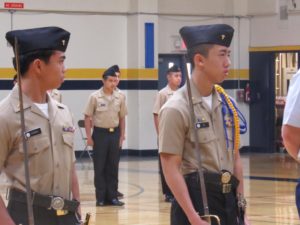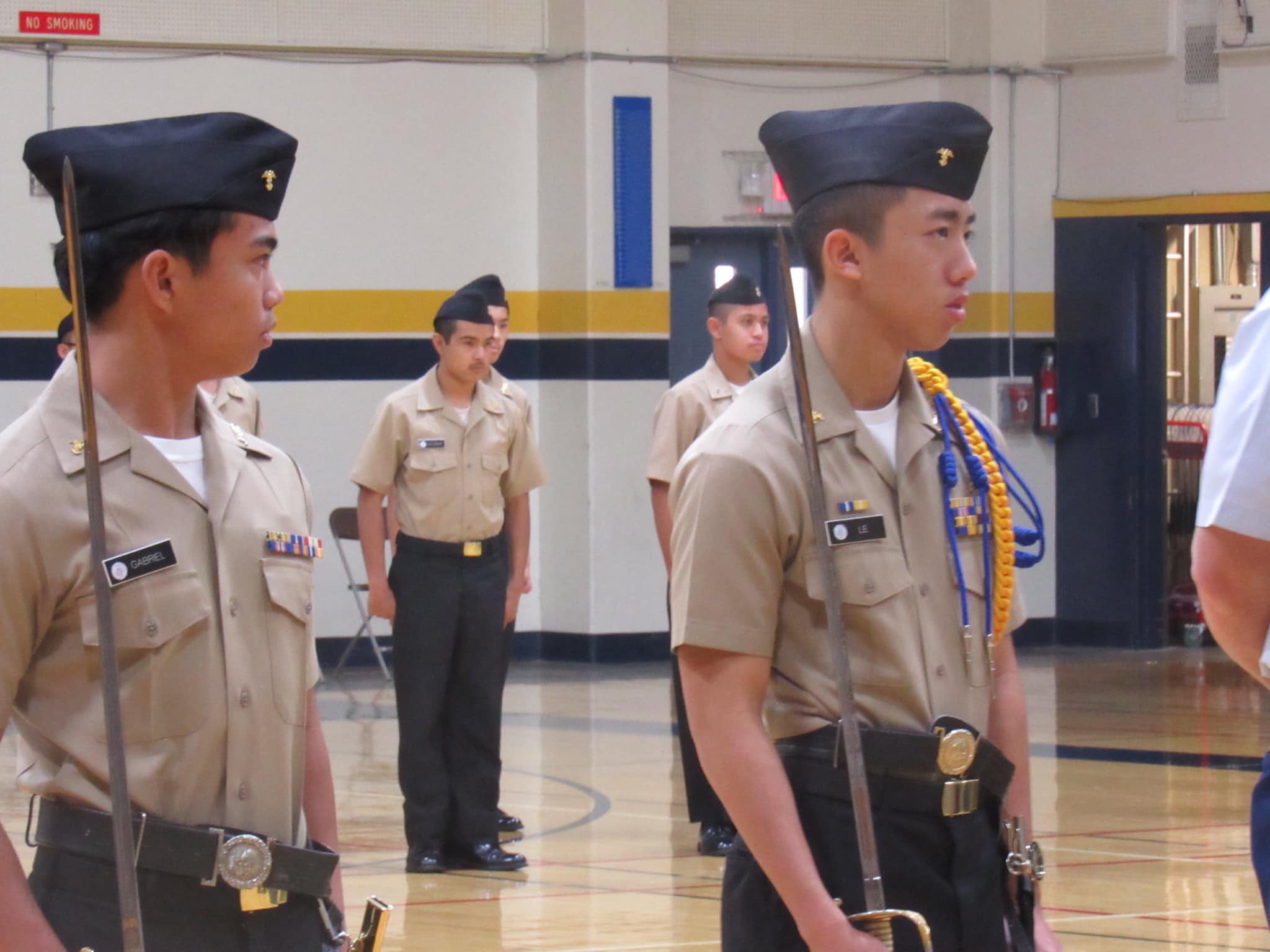
From left to right, Cadet Chief Petty Officer Sean Gabriel, Cadet Chief Seaman Recruit Julian Escobar, Cadet Petty Officer 2nd Class Nolan Calara, and Cafet Chief Petty Officer Victor Le are in uniform during inspection.
By: Maira Ramos
MHS’s Navy Junior Reserve Officers’ Training Corps (NJROTC) program had their annual military inspection in the MHS large gym on Jan. 11, Lieutenant Margie Jackson said. The navy-run program was inspected to determine the fitness of the unit, she said.
The unit’s personnel, procedures, lessons, and cadets are examined to ensure that the navy is investing well, Jackson said. If the inspector finds any discrepancies, then the program would be put on probation, she said.
“Sometimes they would give us enough time to fix it and sometimes, if it’s egregious enough, they will just say ‘Okay, we need to take you out,’” Jackson said. “If the school ever loses this program, they will never get it back. There’s a waiting list for NJROTC and the Navy would just go to the next school on the list.”
According to Jackson, the inspection went well. It was the first time that the guest inspector present for this year’s military inspection had ever inspected a NJROTC unit which may have helped, Jackson said.
“I think that he’s going to give us a passing grade,” Jackson said. “We may not get perfect, but that’s fine as long as we get passing.”
Jackson is the only instructor for the unit this year, Jackson said. The previous Senior Chief and Senior Naval Instructor left, both working at MHS for at least 20 years, she said.
“I have classes here with 9th, 10th, 11th, and 12th graders all in one class,” Jackson said. “I can’t teach four different curriculums at one time and that’s a challenge, so I try to get the advanced cadets to help me out with that.”
Not having a second instructor to separate the four grade levels makes teaching complicated, Cadet Chief Petty Officer Victor Le said. Before Jackson, the students would follow examples of the lessons from the textbooks, he said.
“[Jackson] has been helping us put stuff back on track, and [she has taken] charge of academics,” Le said. “The way we’ve been having students help teach is that the upperclassmen students learn the lessons, then teach it to the underclassmen.”
Administration has been continuously trying to find an additional instructor to teach NJROTC, Principal Francis Rojas said. The program is lacking another teacher, he said.
“[The job has] been posted since almost a year ago,” Rojas said. “But we haven’t been able to find the candidate for that.”
One of the biggest problems that the unit faced this year is that many of their procedures
had not been written down, Le said. The lessons were previously being taught through word of mouth and eventually got distorted over the years, Le said.
“Jackson is helping our unit function the way it should after many years of incorrect procedures,” Le said. “She’s leading us back to the right path, the correct way things should be run, such as our chain of command and our infrastructure.”
Current NJROTC staff members are writing new staff binders to pass down to the future cadets in each position, Le said. The staff binders are a written collection of everything the cadets are supposed to know, from the description of the job to entering information into the database, he said.
“There are also examples of work from the past that the cadets can reference to,” Le said. “In addition to that, I’m really focusing on training because training people is an investment for the future.”
Enrollment in NJROTC has stayed at around 100 students, Rojas said. The goal should be to have about 150 students in the program, so they are trying to explore different options to increase enrollment, especially at the freshman level, he said.
“We can explore, for example, [allowing] ROTC classes to be used for PE credit,” Rojas said. “That’s something that I haven’t explored yet with the PE department, but that’s one opportunity because there’s a significant amount of physical activity for ROTC that allows students to actually open up their skills to make that choice.”
Increasing enrollment numbers is a goal, Jackson said. It is unclear why the numbers have decreased, she said.
“One hundred students is just a drop in the bucket when you compare it to 3,000 students on campus,” Jackson said. “We have to report to the Navy on the first of October and the first of February our enrollment numbers, and if our enrollment falls below 100, we automatically go on probation.”

